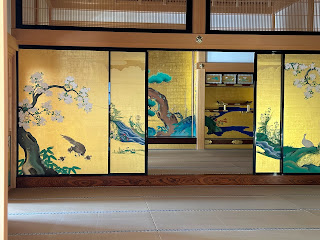After a very easy flight in to Haneda, it took all of about 10 minutes to get through immigration and customs and to the monorail station. Sifting through our collection of old Suica and Pasmo cards, we had a few with sufficient funds to get us out of the airport and into the city proper.
 |
| Our "collection" |
The monorail ride is about 25 minutes, which gave Sumi just enough time to log into the free Tokyo Monorail Wifi (yup, they have a wifi network specifically for a train line that has 10 stops) and get a good map to get to our hotel, as the one from Booking.com was pretty bad. Well, that's what we thought we did. We were staying at the Sotetsu Fresa Inn Daimon and entered that in and got a route. that was a 7 minute walk. We get to the hotel, go up to the counter, and are told that we are at the wrong hotel. We were given directions to the Sotetsu Fresa Inn Hamamatsucho-Daimon, which is about 8 blocks north of the Sotetsu Fresa Inn Daimon. This happens so often that they have a pre-printer flyer to hand out to poor schmucks who make this mistake. It makes you think that maybe, just maybe, they should reconsider their location naming.
 |
| Just...why? |
So, another 7 minute walk got us to the proper hotel, so we got to experience the June humidity for an extra mile. But, all said and done it was one of the easier first days. No luggage, no shipping bikes to a starting point, no rain, no earthquake/tsunami. A nice, relaxing start to the trip.
Tuesday morning saw a quick trip to Family Mart (one of the main konbini chains in Japan) for a rather nostalgic and quick breakfast of yogurt, apple juice, and the plainest, whitest bread you can imagine.
 |
| Famima (Family Mart) brand bread |
 |
| Japanese apple juice is sooooo good... |
A trip to Tokyo station to get all the passes and tickets squared away and we were off on the shinkansen to Nagoya, a city we've never visited. It's the fourth largest city in Japan, after Tokyo (9.7 million), Yokohama (3.8 million), and Osaka (2.8 million). The traffic in that region is always so heavy, we never biked there, and just never got around to going.
Nagoya itself is an important area in Japanese history, being the birthplace of the very first shogun as well as the Three Unifiers: Oda Nobunaga, Toyotomi Hideyoshi, and Tokugawa Ieyasu, who would eventually found the Tokugawa Shogunate and begin the Edo period of Japanese history. As a result there are numerous historical things to see in Nagoya. We saw one: Nagoya Castle. After dropping our bags in a coin locker and getting a daily Nagoya subway pass, we headed to the castle park.
The first thing you will notice about Nagoya Castle is it's moat. It is mostly dry, and it is enormous. Over 20 feet deep and not just encircling the large castle grounds, but snaking between some buildings as well, I estimate it is close to 2 miles or more of rugged, uneven moat now mostly covered by vegetation.
The castle itself was destroyed by Allied bombing in 1945, and was partially restored in 1959. The main keep was damaged by an earthquake in 2018 and deemed unsafe and has been closed since. They're beginning restoration next year. Still, there are numerous intact buildings to see.
 |
| One of the guard towers |
 |
| The main keep |
 |
| Hommaru |
The one building we were able to explore was the Hommaru Palace. This is where the original Lord of Owari (Ieyasu's son, Yoshinao) had administrative offices and was used to house the third Shogun, As a result it was opulent, done up in a very elaborate style called Shoin-zukuri. Taste and restrain were not words used to describe this style. Everything was done to impress and the more important the person using a room, the more that room got. The good news is, a lot of gorgeous artwork was commissioned.
 |
| Lots of rare (for Japan) animals, like tigers and leopards |
 |
| The more important the person, the more ornate their room |
 |
| Carved cypress murals |
 |
| Rooster standing on a taiko drum, which really pops out |
 |
| This ceiling has a unique painting in each section. This was the shogun's quarters |
After walking around in the heat and humidity for a few hours (88 degrees, 100% humidity. They were having typhoons right before we got here), we were in need of lunch. We made it almost 24 hours in Japan before caving and going to Coco Curry.
With a few hours left before things started closing down, we took a train down to Nagoya Port and checked out the Nagoya City Aquarium. It was impressive, boasting orcas, dolphins, penguins, sea turtles, and tons of other sea life. They had a very well-produced dolphin show, complete with a three-camera shoot with video screen and "instant replay" of the dolphin's tricks.
With jet lag catching up to us, we headed back to the station to grab our bags and then a quick walk to the hotel. Tomorrow we're heading to Kyoto for a few days. The weather forecast is back to typhoon, so we may be relegated to doing indoor stuff, we'll see how it goes.
 |
| Subway station outside Nagoya Castle |
 |
| It says "Paper Apron". That is apparently how they say "bib" |
 |
| This is the mailbox for the aquarium |





















No comments:
Post a Comment